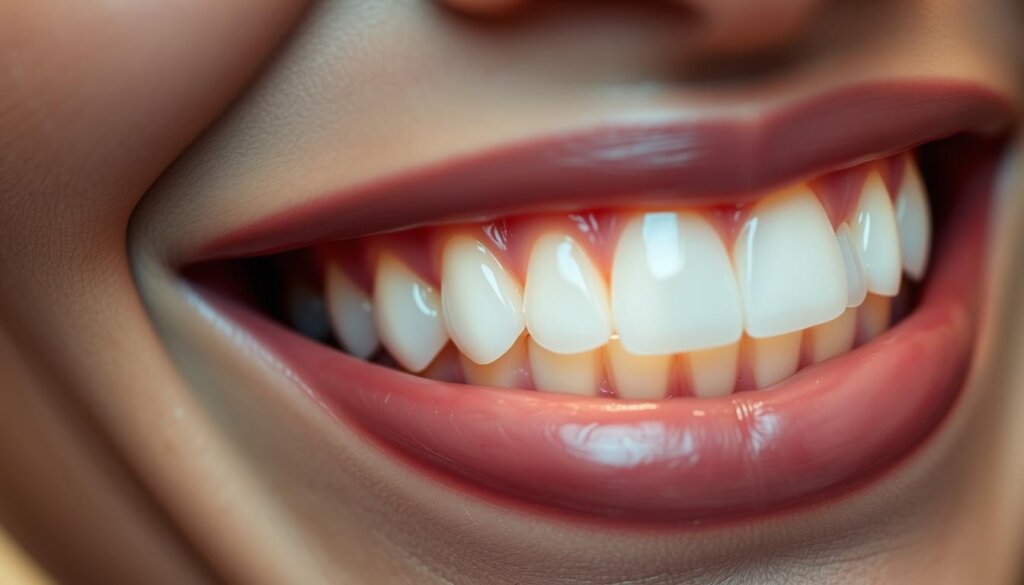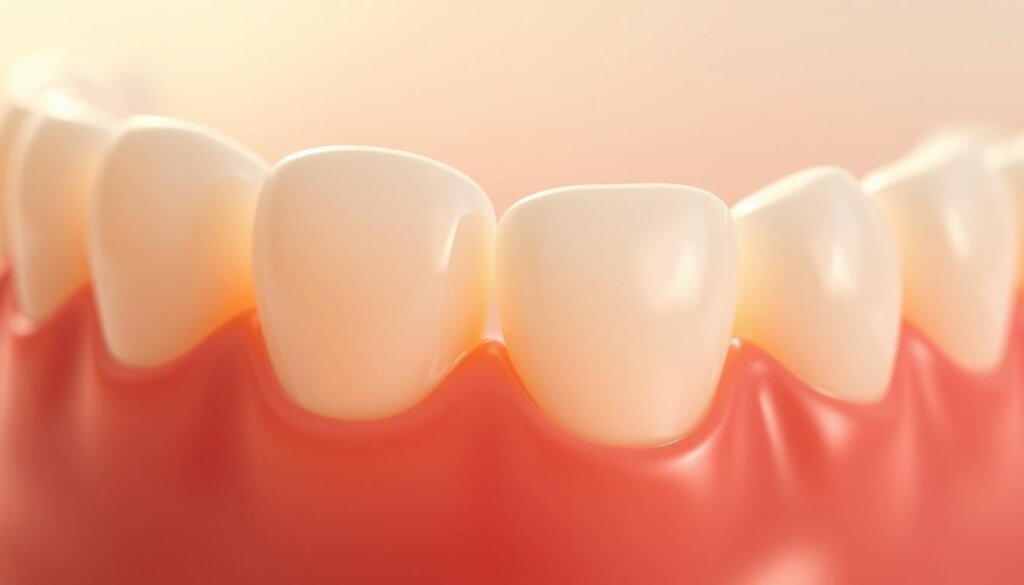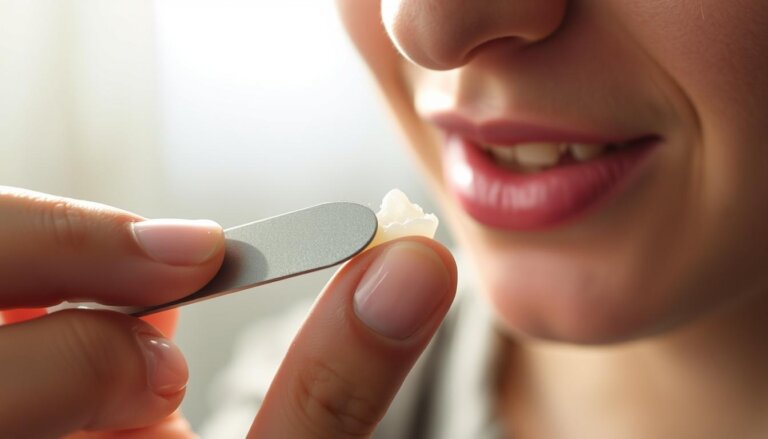How Does a Dentist Decide Between Bonding, Veneer, or Crown for a Broken Tooth?
Every year, over three million Americans deal with chipped or fractured teeth. This raises a big question: how does a dentist choose between bonding, veneer, or crown for a broken tooth? The decision depends on how deep the break is, the patient’s long-term oral health goals, and what they want their smile to look like.
Dentists check if a tooth needs a simple fix or more serious work. For small chips, bonding is a quick solution. Veneers offer both strength and beauty. Crowns are for bigger repairs, covering more of the tooth.
Key Takeaways
- Millions of people seek treatments for broken teeth each year.
- Depth of damage shapes the choice between bonding, veneer, or crown.
- Aesthetic goals influence whether a patient leans toward veneers or bonding.
- Crowns are common for severe structural issues.
- Professionals aim to preserve function and appearance.
Understanding Dental Restoration Options
Many patients wonder why one dental fix is chosen over another. Each method is designed to tackle different problems with teeth. The right choice depends on how much damage there is and what the patient wants in terms of function and looks.
What is Dental Bonding?
Dental bonding uses a resin that blends with the tooth’s surface. It fixes small chips or cracks. This method is quick and keeps most of the healthy enamel intact. It’s perfect for those who need a fast fix.
What are Veneers?
Veneers are placed on the front of the tooth. They hide stains or slight misalignments, making the tooth look more even. Porcelain veneers are made to match the color of your teeth, giving a natural look.
What are Dental Crowns?
Crowns cover the whole tooth when it’s not strong enough. They make the tooth stronger and protect it from getting worse. Dentists use crowns for big problems like deep decay or large cracks.
| Option | Main Advantage | Intended Use |
|---|---|---|
| Bonding | Simple repairs | Minor chips |
| Veneers | Refined aesthetics | Stains, slight shifts |
| Crowns | Full protection | Deep fractures |
Factors Influencing the Decision-Making Process
Clinicians look at many things before choosing a treatment. They want to protect the tooth, keep it looking good, and working right. They check how much enamel is left to decide how to fix chips, cracks, or stains.
Severity of the Tooth Damage
Small cracks might just need a simple fix. But bigger problems need more help. A small chip might get a quick fix, but big cracks might need something stronger to keep the tooth in line.
Patient’s Aesthetic Preferences
People wanting a brighter smile often talk about dental veneers. They can make front teeth look new and fix many problems at once. It’s all about matching the color and how light shows through to blend with other teeth.
Treatment Durability
Doctors think about comfort, how long it lasts, and cost. They check how hard the tooth is used when chewing. Many want something that lasts, so they look into dental veneers or other long-lasting options.
- Extent of decay or breakage
- Budget and maintenance considerations
- Alignment and bite forces
| Factor | Typical Impact | Example Approach |
|---|---|---|
| Structural Damage | Determines degree of coverage | Simple bonding or full crown |
| Aesthetic Goals | Guides material selection | Tooth-colored options |
| Durability Needs | Ensures long-term strength | Reinforced restorations |
Benefits of Dental Bonding
Bonding is a good choice for small tooth problems. It uses composite resin to fix and strengthen the tooth. This method can be a better option than dental crowns for moderate damage, keeping more of the natural tooth.
Affordability and Cost-Effectiveness
It’s often cheaper than more complex treatments. The resin in bonding is less expensive than porcelain. This makes it easier for people on a tight budget to get help.
Clinics might also offer payment plans. These plans help people find ways to protect their teeth without spending a lot.
Quick Procedure and Results
A bonded tooth can be done in just one visit. Dentists apply resin layers, cure, and polish in one go. This means patients can see and feel the difference right away.
Minimal Tooth Preparation
Most of the tooth’s enamel stays the same during bonding. This careful approach keeps the tooth healthy and strong. It’s a great choice for those who want a simple fix without losing too much of the tooth.
Advantages of Veneers
Veneers are a game-changer for fixing broken teeth. They are thin shells that cover the tooth without taking away too much of the natural tooth. They are perfect for small chips, uneven edges, or mild stains.
Modern veneers are made to look just like real teeth. They are comfortable and last a long time.
Natural-Looking Appearance
Dentists use top-quality porcelain or resin for veneers. This material looks just like real teeth. It reflects light well and blends with other teeth for a natural look.
Versatility for Multiple Dental Issues
Veneers can fix many dental problems. They work for small cracks, stains inside the tooth, and uneven shapes. They help make teeth look more even and balanced.
Resistance to Staining
Drinking coffee and tea can stain teeth. But veneers don’t stain easily. They stay white longer, helping you feel confident with your smile every day.
The Case for Dental Crowns
Crowns are a strong fix for badly damaged teeth. They are a top choice when a tooth needs solid protection and support. Some wonder if crowns are too much. But, dentists pick them to keep teeth safe and working well.
Long-Term Durability and Strength
Gold alloys and ceramic mixes are tough against daily wear. They help prevent teeth from breaking, which is key for back teeth. With regular dental visits and clean teeth, a crown can last for years.
Comprehensive Tooth Coverage
A crown covers the whole tooth above the gumline. This is great for fixing big cavities or worn-out enamel. It leads to fewer problems because the whole tooth is supported.
Ideal for Severe Damage
Teeth that have had root canals often get crowns. They act as a shield against more damage. Crowns are a top pick for badly damaged teeth that need a lot of support.
Here’s a look at common crown materials:
| Material | Key Benefit | Visual Appeal |
|---|---|---|
| All-Ceramic | Metal-free strength | High |
| Porcelain-Fused-to-Metal | Durable structure | Moderate |
| Gold Alloy | Extremely strong | Lower |
Aesthetic Considerations in Treatment
Clinicians aim to make restored teeth look like the real thing. This is important for both looks and function. Many people want their teeth to look as natural as possible after dental work.
Matching Colors and Textures
Shade guides and special shading techniques help match tooth colors. Details like translucence near the edges make the teeth look real. This way, restorations look like natural enamel under different lights.
Importance of Customization
Every patient gets a treatment that fits their needs and comfort. Changes in texture, shine, and glow make each restoration unique. Working together, dentist and patient choose the best look.
What to Expect After Treatment
Some people might feel a little sensitivity after getting crowns, veneers, or bonding. But, with good home care and fluoride rinses, it usually goes away. Within a few weeks, teeth settle, and smiles look more natural.
Time Factors for Each Treatment Option
Some people want quick fixes for their teeth. Bonding is fast, often done in one visit. It’s perfect for those in a hurry or with busy lives.
Crowns and veneers take longer, needing two visits. The first is for shaping and making impressions. The second is for placing the final piece, made to fit perfectly.
These options fit different lifestyles. We aim to make the process quick and effective.
Duration of Each Procedure
Bonding is quick, sometimes done in under an hour. Veneers need two visits: one for prep and another for placement. Crowns also need two visits, but time can vary.
Recovery Time and Follow-Up Care
After treatment, adjustments may be needed. Quick checkups ensure everything looks and feels right. Regular visits, every month or two, keep things comfortable and in place.
| Procedure | Typical Timeframe |
|---|---|
| Bonding | Single Appointment |
| Veneers | Two Appointments |
| Crowns | Two Appointments |
Cost Comparison: Bonding, Veneers, Crowns
Patients with chipped or fractured teeth often wonder about the cost of fixing them. Dentists look at several factors to figure out the price. These include the materials used, how many teeth are damaged, and how complex the repair is.
Pricing Overview
Bonding is generally the most affordable option. But, the cost can go up if you choose high-quality materials. Veneers are a bit pricier, with porcelain ones lasting longer and keeping their color better. Crowns are the most expensive because they involve lab work.
Insurance Considerations
Insurance often covers part of the cost, but it depends on the procedure’s purpose. Veneers usually don’t get much insurance help because they’re seen as cosmetic. But, crowns might be covered if they’re needed to strengthen a tooth.
Financing Options
Some dental offices offer payment plans or work with CareCredit. This makes it easier for patients to afford the treatments they need. It helps them get the care they want without breaking the bank.
| Treatment | Average Cost (USD) | Insurance Coverage |
|---|---|---|
| Bonding | $100–$350 | Usually partial |
| Veneers | $600–$2,500 | Rarely included |
| Crowns | $800–$3,000 | Partially covered if restorative |
Maintenance Requirements
Daily care is key to keeping any dental treatment stable. Stress on teeth can ruin the results of dental work. Brushing gently and eating carefully helps keep treatments working well.

Caring for Bonded Teeth
Resin materials need careful handling. Avoid harsh brushing or biting on ice to prevent damage. Use a soft-bristled brush for cleaning and floss gently to protect the edges.
Caring for Veneers
Porcelain veneers resist stains well, but regular cleaning keeps them bright. Avoid dark foods and drinks to prevent dulling. Be careful not to bite hard on veneers to avoid chipping. Regular dental check-ups can catch early wear.
Caring for Crowns
Crowns need gentle care to protect your gums. Brush with moderate pressure to avoid plaque buildup. Regular dental visits can spot damage early, keeping your crowns effective.
When to Seek a Second Opinion
At times, getting a second opinion can clear up confusion about broken tooth dental treatments. Many people feel better when they hear different views from experts. This can help when big decisions are involved.
Importance of Consulting Different Dentists
Dentists might prefer different methods or materials. Talking to another dentist, like one from the American Dental Association, can show other ways to fix problems. This can help decide if a simple fix is enough or if something more is needed.
Signs You Might Need Additional Advice
If you’re not sure about a treatment or feel uneasy, you might need more advice. Big plans that seem too much for the damage also need a second look. Getting different opinions helps make informed choices and keeps your teeth healthy for a long time.
- Compare estimated costs and benefits
- Review long-term outcomes of each method
- Verify compatibility with insurance coverage
| Reason for Seeking Another Opinion | Potential Benefit |
|---|---|
| Unclear treatment plan | Greater confidence in chosen option |
| High cost estimates | Chance to explore financial alternatives |
| Persistent discomfort | Prescription or procedural adjustments |
Common Myths and Misconceptions
Many people think cosmetic dentistry is just for looks. But, experts from the American Academy of Cosmetic Dentistry say it’s more than that. They believe some myths stop people from getting help for their teeth.
Looking into these myths helps patients find the best solutions for their needs.
Misunderstandings about Dental Bonding
Some think bonding is too weak for everyday use. But, new resin materials are strong enough for chewing and biting. Regular dental visits help keep it in good shape.
Misconceptions Surrounding Veneers
Many believe veneers look fake or harm teeth. But, ADA-certified clinics use methods that are gentle on teeth. They also match the veneer’s color to your teeth for a natural look.
Myths About Dental Crowns
Some think crowns are only for looks. But, dental experts say they protect teeth and help them work again after damage or decay.
| Myth | Reality |
|---|---|
| Bonding Easily Breaks | Quality resins last for years with routine maintenance |
| Veneers Look Unnatural | Modern veneers can mimic natural tooth color and shape |
| Crowns Are Only Cosmetic | Crowns offer vital structural support for damaged teeth |
Real-Life Applications: Case Studies
Real-world examples show how custom dental solutions can bring back smiles. The American Dental Association’s clinicians often talk about how bonding, veneers, and crowns improve function and confidence.
Successful Bonding Treatment Examples
A patient with a small chip on a front tooth chose resin bonding. This method saved healthy enamel and gave a smooth, natural look. It also improved speech and needed little follow-up.
Healing with Veneers: Patient Experiences
In a major Chicago clinic, porcelain veneers fixed deep stains. The team used computer design to make thin shells that matched the patient’s teeth. Patients reported feeling more confident and happy with the results.
Crowning Achievements: Patient Testimonials
A New York practice shared a story of a patient with big decay issues. Full-coverage crowns fixed biting support and offered lasting strength. The outcome was both beautiful and stable.
| Treatment Type | Key Benefit | Typical Result |
|---|---|---|
| Bonding | Minimal tooth reduction | Quick cosmetic fix |
| Veneers | Custom porcelain design | Long-lasting brightness |
| Crowns | Comprehensive coverage | Sturdy bite support |
The Role of Technology in Decision Making
Modern devices have changed how dentists plan and do treatments. Clinics now use precise diagnostics and advanced software. This helps make restorations that fit each patient’s teeth perfectly.
This method makes treatments more accurate. It also builds trust when choosing bonding, veneers, or crowns.
Digital Tools for Treatment Planning
Intraoral scanners like CEREC or 3Shape Trios take detailed pictures of teeth. They replace messy molds. This makes planning restorations easier.
Doctors use these scans to design restorations on special software. It maps tooth surfaces and guides material choice. This makes talking to patients easier and boosts confidence in the plan.
Impact of 3D Imaging
Three-dimensional modeling shows hidden details. It helps make custom-fit crowns or veneers. High-resolution images show small defects clearly.
They let teams see what the outcome will be before starting. This reduces uncertainty. It leads to more successful and satisfying dental results.
Conclusion: Making the Right Choice
A dentist looks at the damage, what looks good, and how long it lasts when choosing bonding, veneers, or crowns. Each option has its own benefits. The best choice often depends on how bad the tooth damage is and what the patient wants.
A broken tooth might need extra support. But small chips can be fixed quickly.
Summary of Key Points
Dental bonding is a cost-effective option for small cracks or moderate wear. Veneers cover the front of teeth and are great for a bright, uniform look. Crowns protect a tooth on all sides and are best for serious damage.
Time and money matter. Bonding is fast, veneers balance looks and strength, and crowns add strong support for a weak bite.
Final Thoughts on Choosing the Best Option
There’s no one solution for every tooth problem. Working together, dentist and patient can find the best fit. This approach considers the patient’s lifestyle, budget, and style.
By weighing the pros and cons of each option, they can make a choice that lasts. This choice can bring back confidence and comfort for years.





